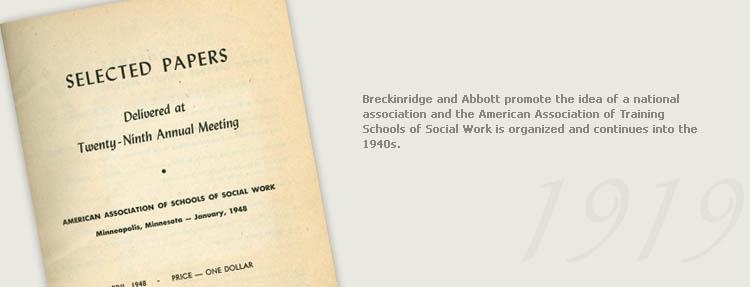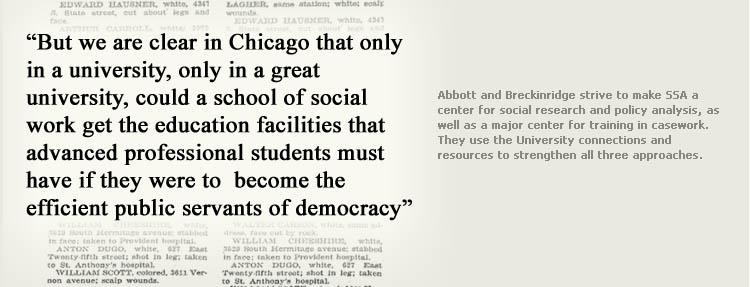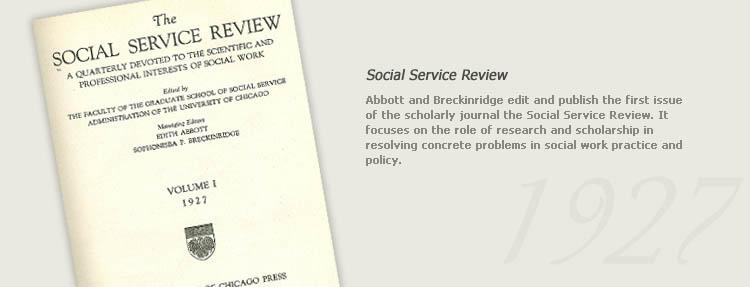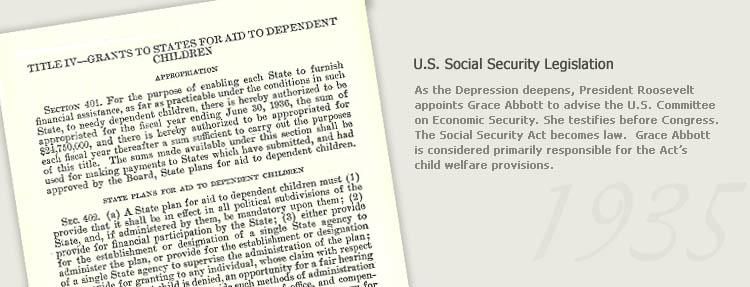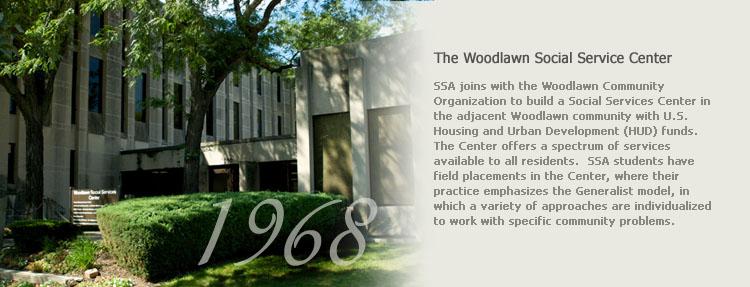Timeline
A Century of Scholarship and Practice
The origins of our School begins in 1908, with the founding of the Chicago School of Civics and Philanthropy. In 1920, the School became one of the University of Chicago's graduate schools and was renamed the School of Social Service Administration. In January, 2021, James and Paula Crown and their family gave a $75 million dollar gift to the School, which was renamed the Crown Family School of Social Work, Policy, and Practice.

SSA’s founding begins much before its official date of 1908. Graham Taylor, Chicago Commons Settlement Director, creates the School of Social Economics, offering social and economic lectures. Lecturers include Jane Addams and John Dewey.

Taylor, observing the increasing demand by social service agencies for the School’s attendees, approaches the University of Chicago to suggest an extension program. Julia Lathrop becomes a lecturer.
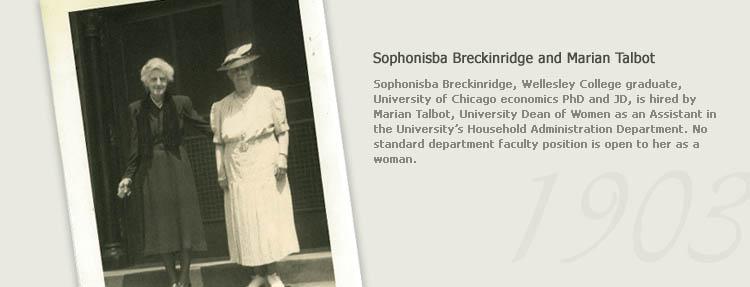
Sophonisba Breckinridge, Wellesley College graduate, University of Chicago economics PhD and JD, is hired by Marian Talbot, University Dean of Women, as an Assistant in the University’s Household Administration Department. No standard department faculty position is open to her as a woman.
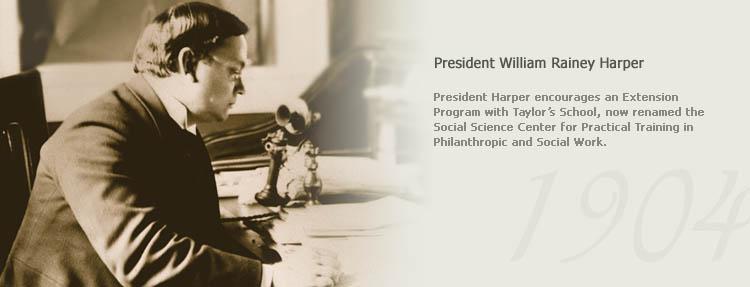
President Harper encourages an Extension Program with Taylor’s School, now renamed the Social Science Center for Practical Training in Philanthropy and Social Work.

The Extension Program, now the Institute for Social Science and Arts: Training for Philanthropy and Social Work, holds courses at both the Commons and the University, adding theory to the practical courses.
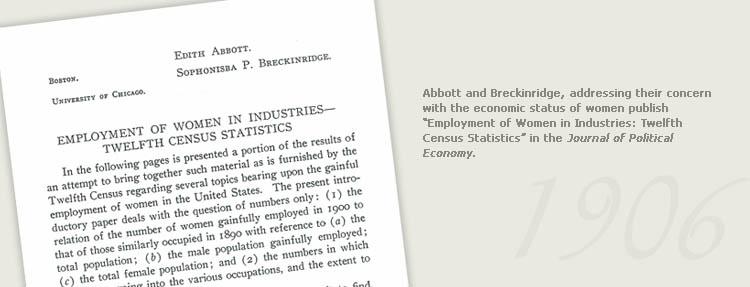
Abbott and Breckinridge, addressing their concern with the economic status of women, publish “Employment of Women in Industries: Twelfth Census Statistics” in the Journal of Political Economy.
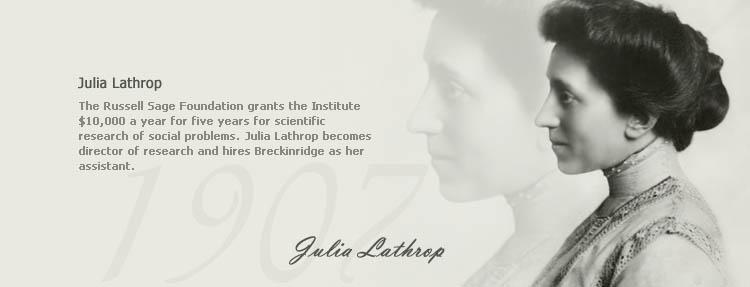
The Russell Sage Foundation grants the Institute $10,000 a year for five years for scientific research of social problems. Julia Lathrop becomes director of research and hires Breckinridge as her assistant.
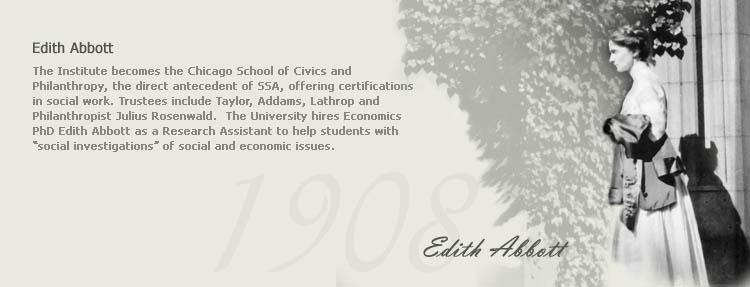
The Institute becomes the Chicago School of Civics and Philanthropy, the direct antecedent of SSA, offering certifications in social work. Trustees include Taylor, Addams, Lathrop, and philanthropist Julius Rosenwald. The University hires Economics PhD Edith Abbott as a Research Assistant to help students with “social investigations” of social and economic issues.

Breckinridge becomes Dean of the Chicago School of Civics and Philanthropy. The faculty adopts a “philosophy that links accurate measurement of social conditions with solutions to social problems.”
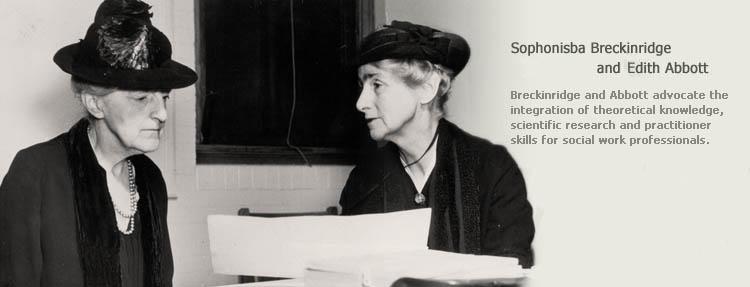
Breckinridge and Abbott advocate the integration of theoretical knowledge, scientific research, and practitioner skills for social work professionals.
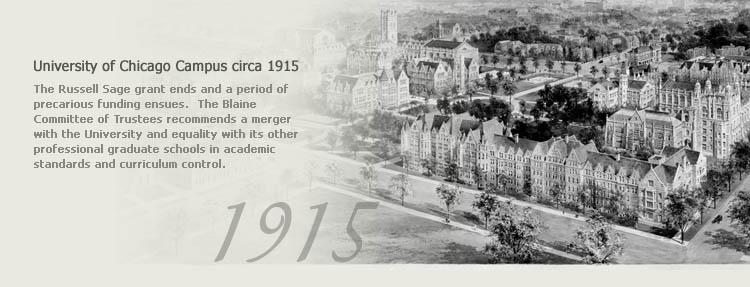
The Russell Sage grant ends and a period of precarious funding ensues. The Blaine Committee of Trustees recommends a merger with the University and equality with its other professional graduate schools in academic standards and curriculum control.
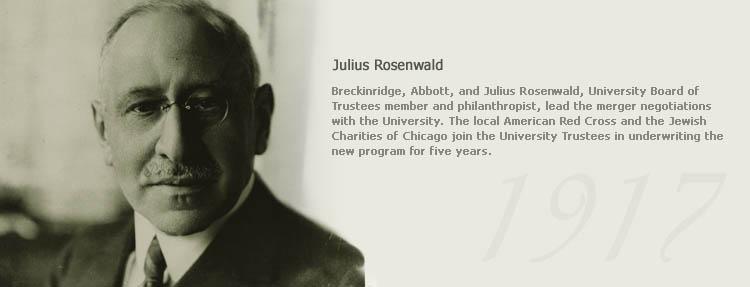
Breckinridge, Abbott, and Julius Rosenwald, University Board of Trustees member and philanthropist, lead the merger negotiations with the University. The local American Red Cross and the Jewish Charities of Chicago join the University Trustees in underwriting the new program for five years.
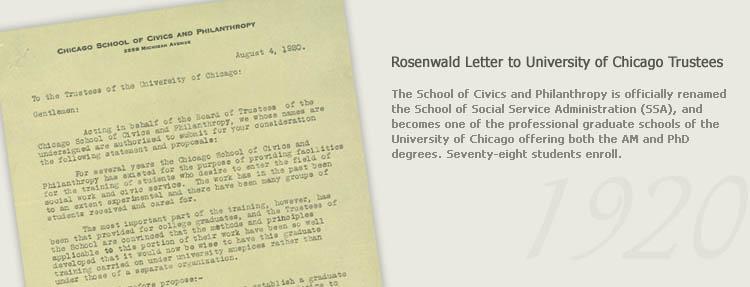
The School of Civics and Philanthropy is officially renamed the School of Social Service Administration (SSA), and becomes one of the professional graduate schools of the University of Chicago offering both the AM and PhD degrees. Seventy-eight students enroll.
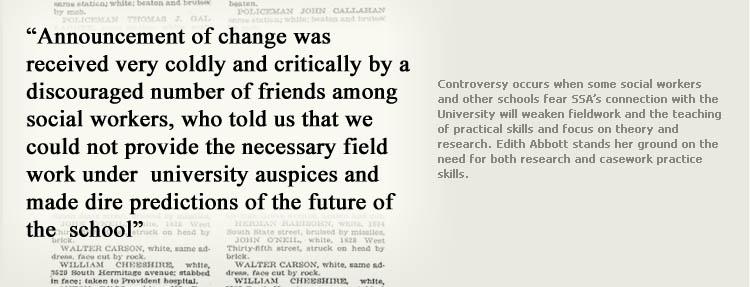
Controversy occurs when some social workers and other schools fear SSA’s connection with the University will weaken fieldwork and the teaching of practical skills with its focus on theory and research. Edith Abbott stands her ground on the need for both research and casework practice skills.
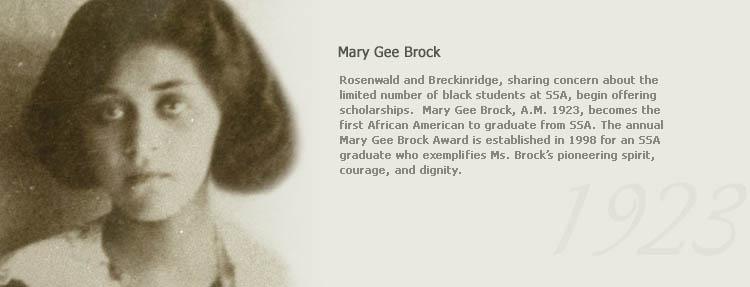
Rosenwald and Breckinridge, sharing concern about the limited number of black students at SSA, begin offering scholarships. Mary Gee Brock, AM 1923, becomes the first African American to graduate from SSA. The annual Mary Gee Brock Award is established in 1998 for an SSA graduate who exemplifies Ms. Brock’s pioneering spirit, courage, and dignity.
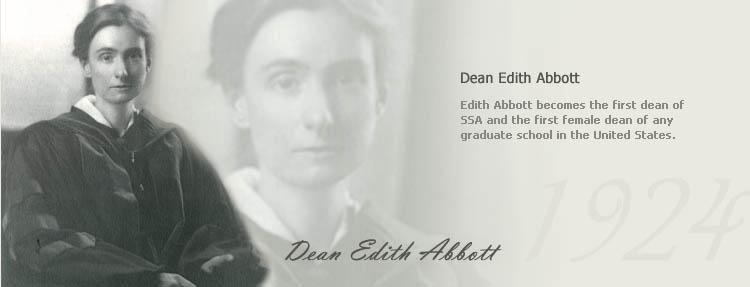
Edith Abbott becomes the first dean of SSA and the first female dean of any graduate school in the United States.
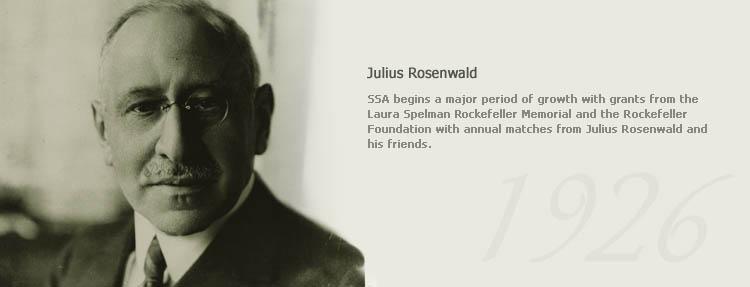
SSA begins a major period of growth with grants from the Laura Spelman Rockefeller Memorial and the Rockefeller Foundation with annual matches from Julius Rosenwald and his friends.
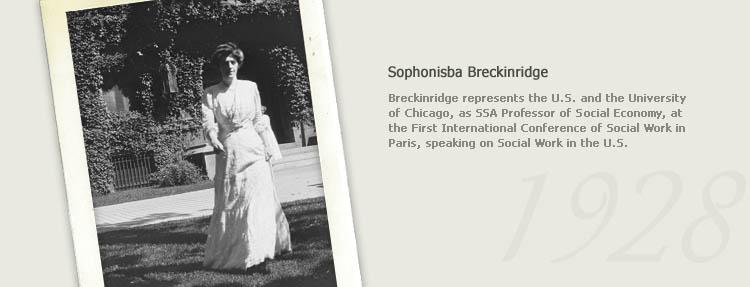
Breckinridge represents the US and the University of Chicago, as SSA Professor of Social Economy, at the First International Conference of Social Work in Paris, speaking on Social Work in the US.
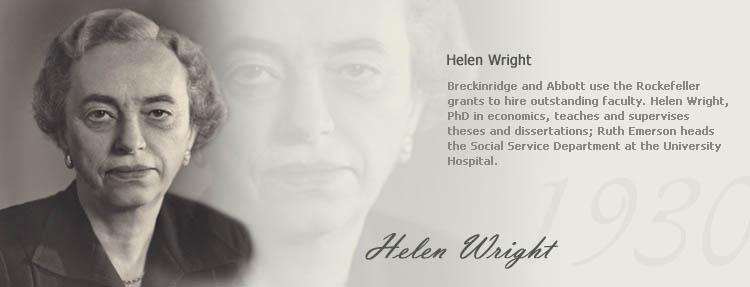
Breckinridge and Abbott use the Rockefeller grants to hire outstanding faculty. Helen Wright, PhD in economics, teaches and supervises theses and dissertations; Ruth Emerson heads the Social Service Department at the University Hospital.
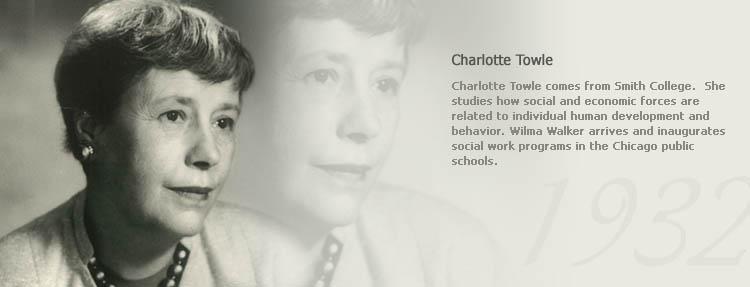
Charlotte Towle comes from Smith College. She studies how social and economic forces are related to individual human development and behavior. Wilma Walker arrives and inaugurates social work programs in the Chicago Public Schools.
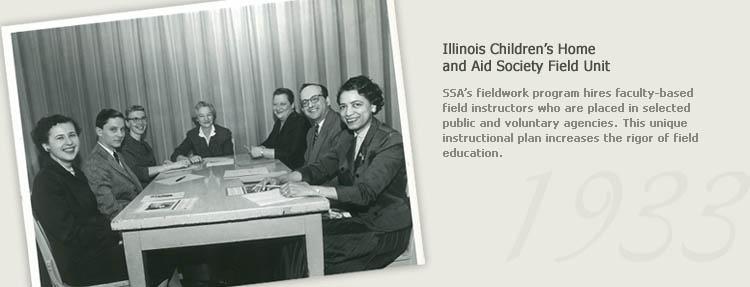
SSA’s fieldwork program hires faculty-based field instructors who are placed in selected public and voluntary agencies. This unique instructional plan increases the rigor of field education.

Grace Abbott resigns as Director of the US Children’s Bureau seeking greater freedom to speak and write. She teaches at SSA and assumes editorship of the Social Service Review from sister Edith Abbott and Breckinridge.

SSA trains 179 relief workers for the Federal Emergency Relief Administration to understand the legislative process and the needs of communities.
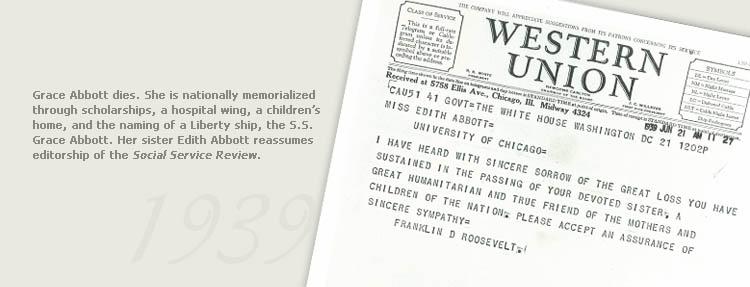
She is nationally memorialized through scholarships, a hospital wing, a children’s home, and the naming of a Liberty ship, the S.S. Grace Abbott. Her sister Edith Abbott reassumes editorship of the Social Service Review.

SSA’s curriculum focuses increasingly on the common fundamental principles underlying all work of the profession, and emphasizing scientific methods to study and investigate social problems.
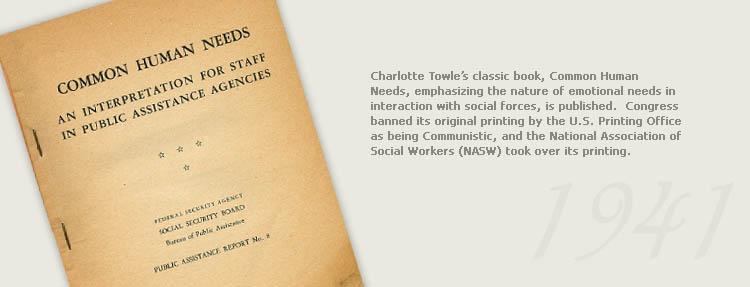
Edith Abbott retires but continues to teach. Helen Wright succeeds Edith Abbott as Dean of SSA.

The Douglas Smith Fund supports the expansion of the medical and psychiatric fieldwork programs in the Division of Medical Care of the Chicago Relief Administration. Bernece Simon supervises the field unit at the Michael Reese Hospital.
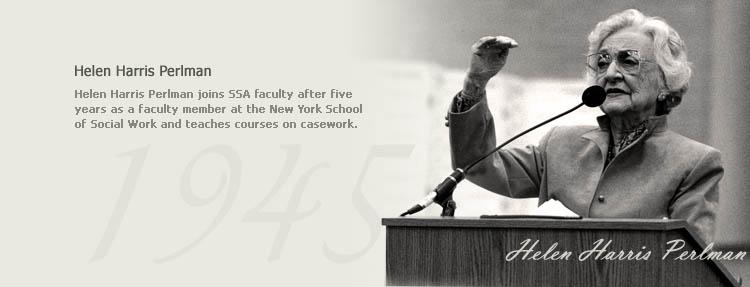
Helen Harris Perlman joins SSA faculty after five years as a faculty member at the New York School of Social Work and teaches courses on casework.
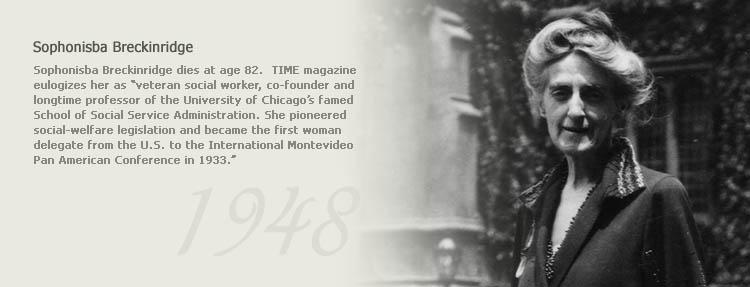
Sophonisba Breckinridge dies at age 82. TIME magazine eulogizes her as a “veteran social worker, co-founder and longtime professor of the University of Chicago’s famed School of Social Service Administration. She pioneered social-welfare legislation and became the first woman delegate from the US to the International Montevideo Pan American Conference in 1933.”
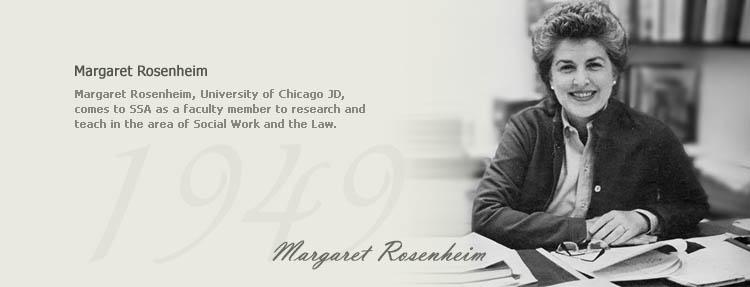
Margaret Rosenheim, University of Chicago JD, comes to SSA as a faculty member to research and teach in the area of Social Work and the Law.

Dean Wright raises funds to create an SSA Research Center. Studies directed by Lillian Ripple and summarized in a book, Motivation, Capacity, and Opportunity, represent some of the Center’s most influential research. The book is used in many social work schools.

Dean Wright becomes editor of the Social Service Review.
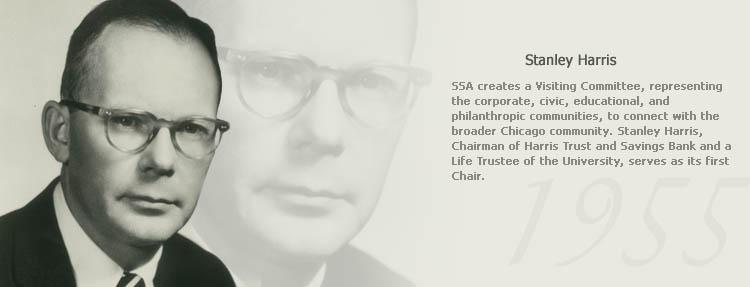
SSA creates a Visiting Committee, representing the corporate, civic, educational, and philanthropic communities, to connect with the broader Chicago community. Stanley Harris, Chairman of Harris Trust and Savings Bank and a Life Trustee of the University, serves as its first Chair.
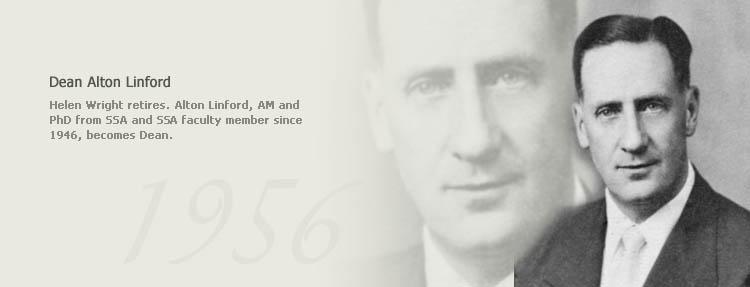
Helen Wright retires. Alton Linford, AM and PhD from SSA and SSA faculty member since 1946, becomes Dean.

Helen Harris Perlman publishes Casework: A Problem-Solving Process. The book becomes the primary casework text used in social work schools. It is published in 16 languages.
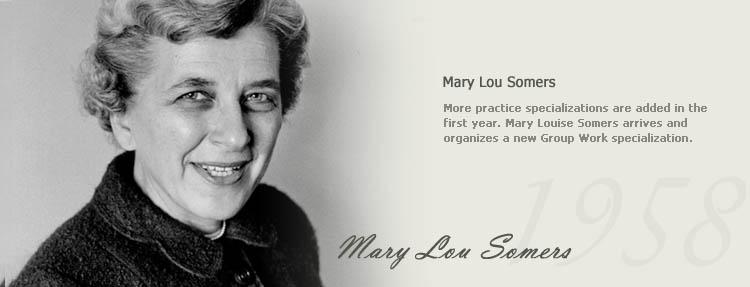
More practice specializations are added in the first year. Mary Louise Somers arrives and organizes a new Group Work specialization.
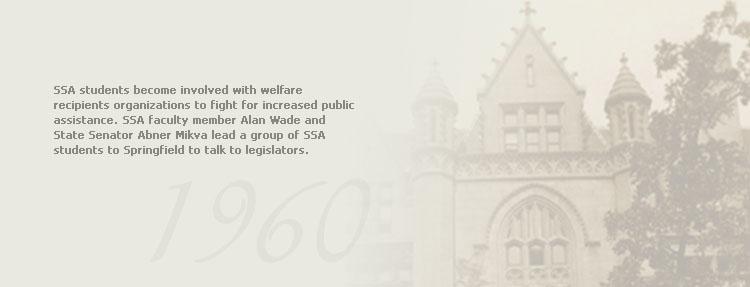
SSA students become involved with welfare recipient organizations to fight for increased public assistance. SSA faculty member Alan Wade and State Senator Abner Mikva lead a group of SSA students to Springfield to talk to legislators.

Irving Spergel joins the faculty and teaches community organization with an emphasis on community collaboration around youth issues.
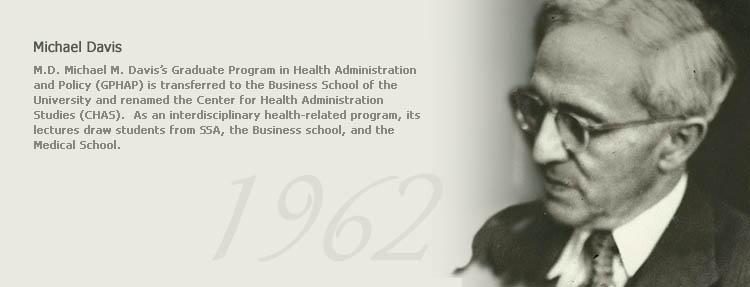
Dr. Michael M. Davis’s Graduate Program in Health Administration and Policy (GPHAP) is transferred to the Business School of the University and renamed the Center for Health Administration Studies (CHAS). As an interdisciplinary health-related program, its lectures draw students from SSA, the Business School, and the Medical School.
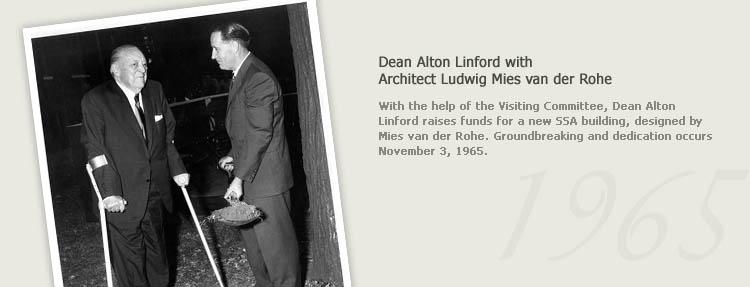
With the help of the Visiting Committee, Dean Alton Linford raises funds for a new SSA building, designed by Mies van der Rohe. Groundbreaking and dedication occurs on November 3, 1965.

Dean Linford resigns. Harold Richman, White House Fellow, AM and PhD from SSA and SSA faculty member beginning in 1968, becomes Dean. University President Edward Levy gives him a mandate to “pick up the mantle of the founding women” and work toward the intersection of research, scholarship, practice and policy to produce change that will lessen inequality and injustice.”

Dean Richman secures the Consolidated Grant from the US Department of Health Education and Welfare (HEW). The grant is a HEW experiment to streamline government by moving away from categorical funding for specific services to a consolidation of all services within one grant. Renewed annually until 1979, the Grant permits SSA to expand its curriculum diversity and student financial aid.
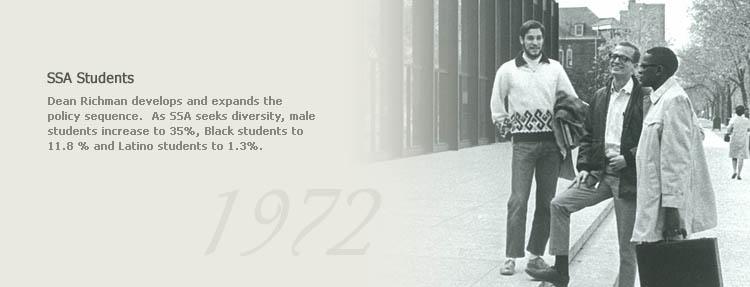
Dean Richman develops and expands the policy sequence. As SSA seeks diversity, male students increase to 35%, Black students to 11.8% and Latino students to 1.3%.

Faculty Member Charles Shireman develops a National Center for the Assessment of Alternatives to Juvenile Justice Processing.
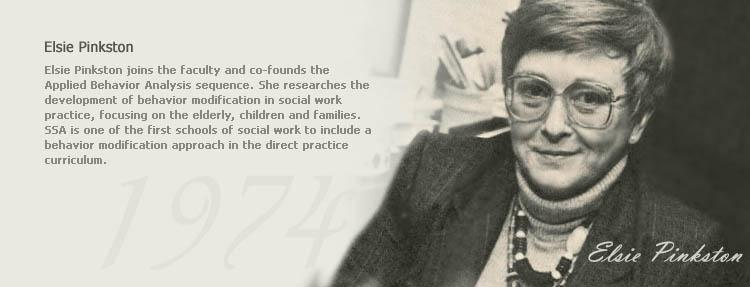
Elsie Pinkston joins the faculty and co-founds the Applied Behavior Analysis sequence. She researches the development of behavior modification in social work practice, focusing on the elderly, children, and families. SSA is one of the first schools of social work to include a behavior modification approach in the direct practice curriculum.
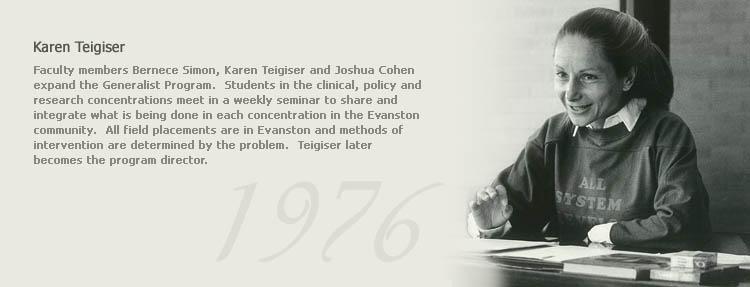
Faculty members Bernece Simon, Karen Teigiser, and Joshua Cohen expand the Generalist Program. Students in the clinical, policy, and research concentrations meet in a weekly seminar to share and integrate what is being done in each concentration in the Evanston community. All field placements are in Evanston and methods of intervention are determined by the problem. Teigiser later becomes the program director.
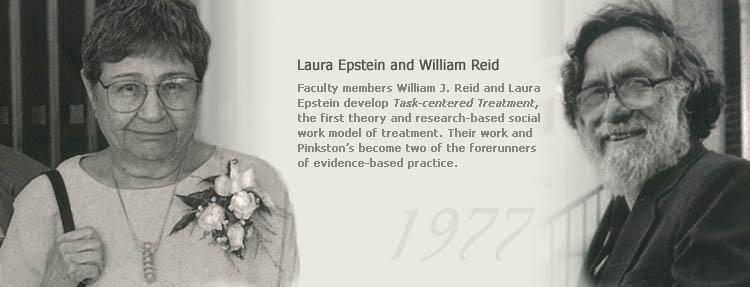
Faculty members William J. Reid and Laura Epstein develop Task-centered Treatment, the first theory and research-based social work model of treatment. Their and Pinkston’s work becomes two frontrunners of evidence-based practice.
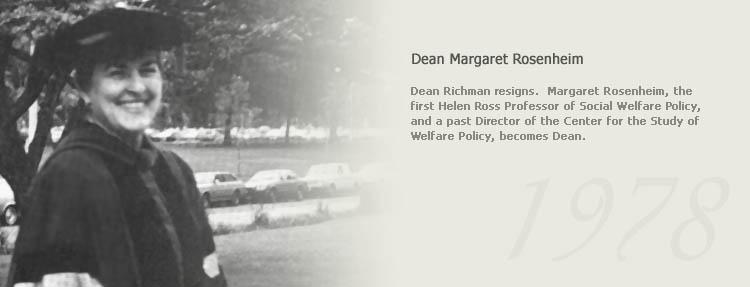
Dean Richman resigns. Margaret Rosenheim, the first Helen Ross Professor of Social Welfare Policy, and a past Director of the Center for the Study of Welfare Policy, becomes Dean.
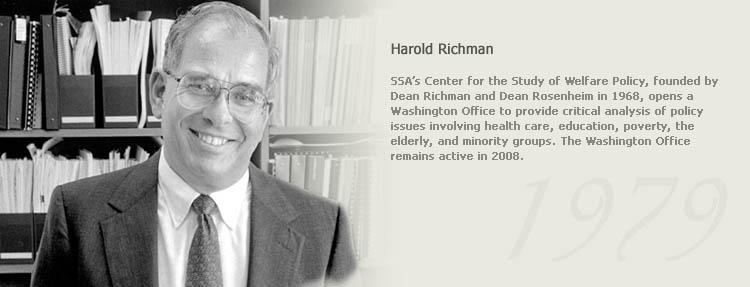
SSA’s Center for the Study of Welfare Policy, founded by Dean Richman and Dean Rosenheim in 1968, opens a Washington Office to provide critical analysis of policy issues involving health care, education, poverty, the elderly, and minority groups. The Washington Office remains active to this day.
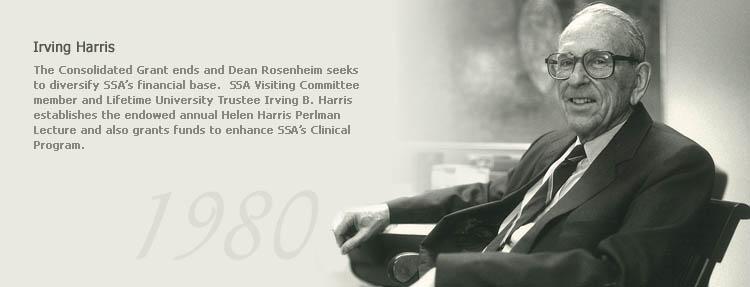
The Consolidated Grant ends and Dean Rosenheim seeks to diversify SSA’s financial base. SSA Visiting Committee member and Lifetime University Trustee Irving B. Harris establishes the endowed annual Helen Harris Perlman Lecture. He also grants funds to enhance SSA’s Clinical Program.
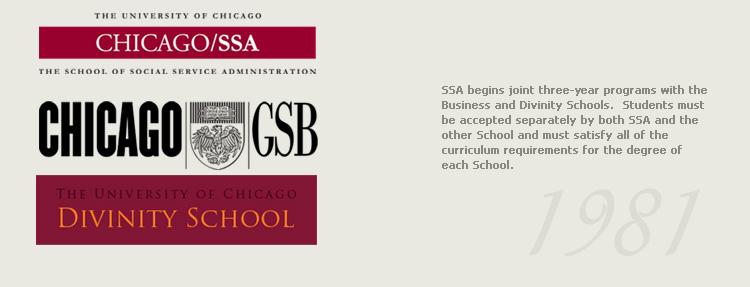
SSA begins joint three-year programs with the Business and Divinity Schools. Students must be accepted separately by both SSA and the other School and must satisfy all of the curriculum requirements for the degree of each School.
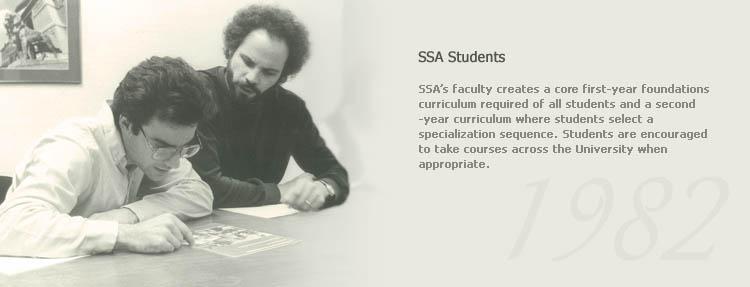
SSA’s faculty creates a core first-year foundations curriculum required of all students and a second-year curriculum where students select a specialization sequence. Students are encouraged to take courses across the University when appropriate.
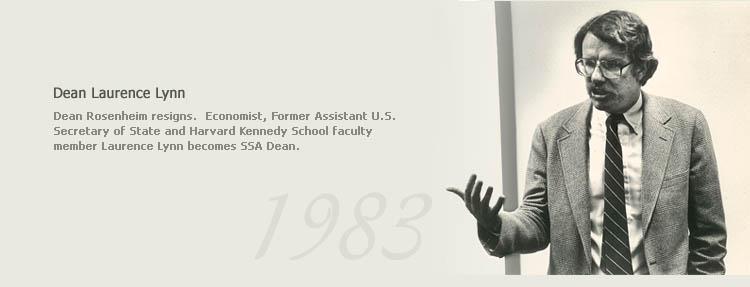
Dean Rosenheim resigns. Economist, Former Assistant US Secretary of State and Harvard Kennedy School faculty member Laurence Lynn becomes SSA Dean.
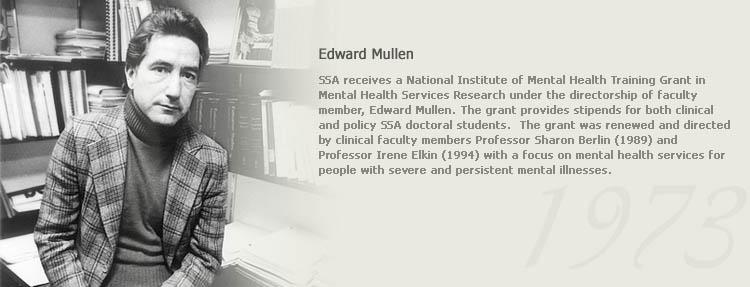
SSA receives a National Institute of Mental Health Training Grant in Mental Health Services Research under the directorship of faculty member, Edward Mullen. The grant provides stipends for both clinical and policy SSA doctoral students. The grant was renewed and directed by clinical faculty members Professor Sharon Berlin (1989) and Professor Irene Elkin (1994) with a focus on mental health services for people with severe and persistent mental illnesses.
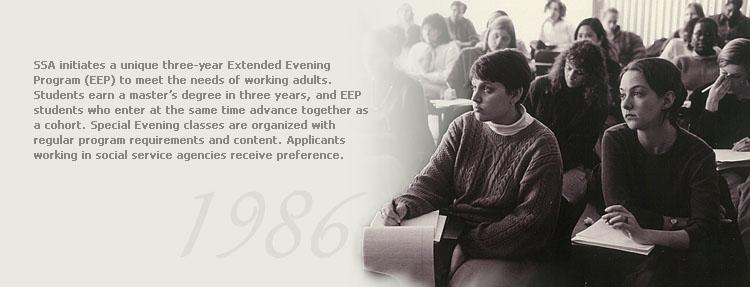
SSA initiates a unique three-year Extended Evening Program (EEP) to meet the needs of working adults. Students earn a master’s degree in three years, and EEP students who enter at the same time advance together as a cohort. Special Evening classes are organized with regular program requirements and content. Applicants working in social service agencies receive preference.

Faculty member and past Associate Dean John Schuerman becomes editor of the Social Service Review.
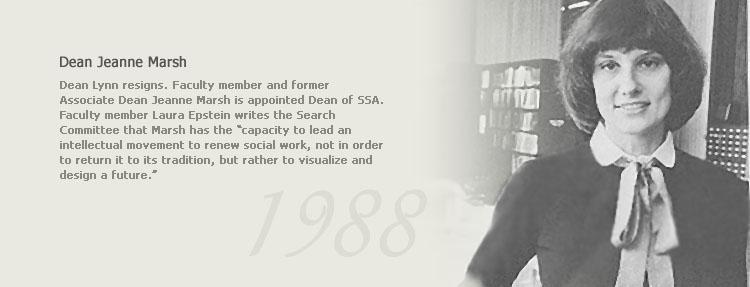
Dean Lynn resigns. Faculty member and former Associate Dean Jeanne Marsh is appointed Dean of SSA. Faculty member Laura Epstein writes the Search Committee that Marsh has the “capacity to lead an intellectual movement to renew social work, not in order to return it to its tradition, but rather to visualize and design a future.”
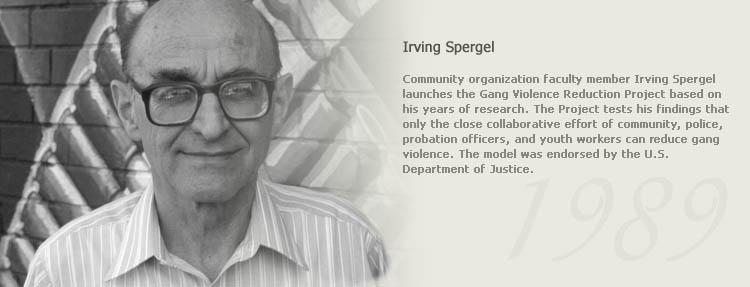
Community organization faculty member Irving Spergel launches the Gang Violence Reduction Project based on his years of research. The Project tests his findings that only the close collaborative effort of community, police, probation officers, and youth workers can reduce gang violence. The model was endorsed by the US Department of Justice.
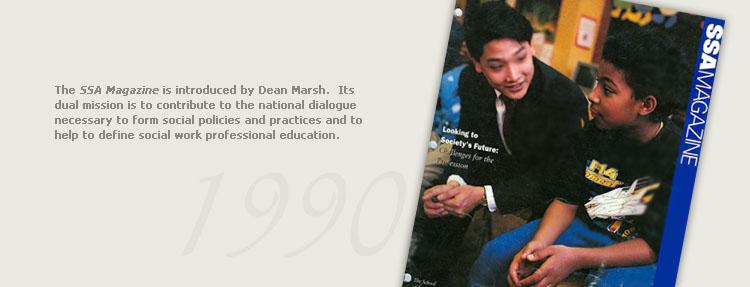
The SSA Magazine is introduced by Dean Marsh. Its dual mission is to contribute to the national dialogue necessary to form social policies and practices and to help to define social work professional education.

Dean Marsh brings the Center for Health Administration Studies (CHAS) to SSA with a transition grant from Visiting Committee Member Mrs. Beatrice Cummings Mayer. She appoints faculty member Edward Lawlor as Director. The Michael Davis Lectures continue at SSA, and students from SSA, Business, Public Policy, and Medicine can apply for a Fellowship.
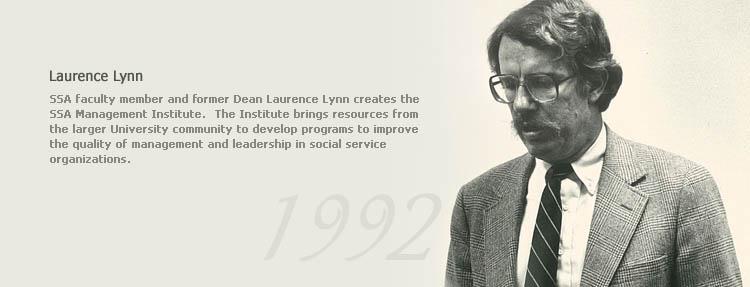
SSA faculty member and former Dean Laurence Lynn creates the SSA Management Institute. The Institute brings resources from the larger University community to develop programs to improve the quality of management and leadership in social service organizations.

Jeanne Marsh leads a period of growth and revitalization of programs of education and research. She is reappointed Dean for a second five-year term by President Hanna Holborn Gray who writes, “The reappointment is great for the School and the University.”
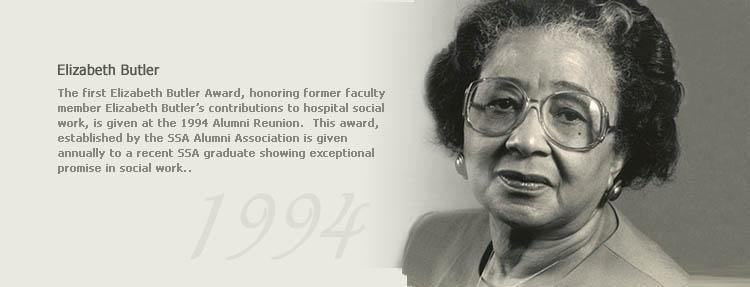
The first Elizabeth Butler Award, honoring former faculty member Elizabeth Butler’s contributions to hospital social work, is given at the 1994 Alumni Reunion. This award, established by the SSA Alumni Association is given annually to a recent SSA graduate showing exceptional promise in social work.
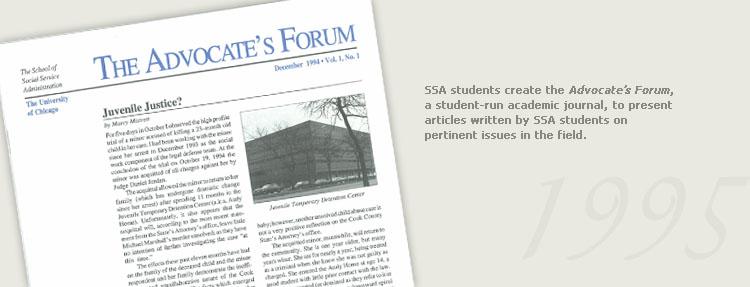
SSA students create the Advocate’s Forum, a student-run academic journal, to present articles written by SSA students on pertinent issues in the field.
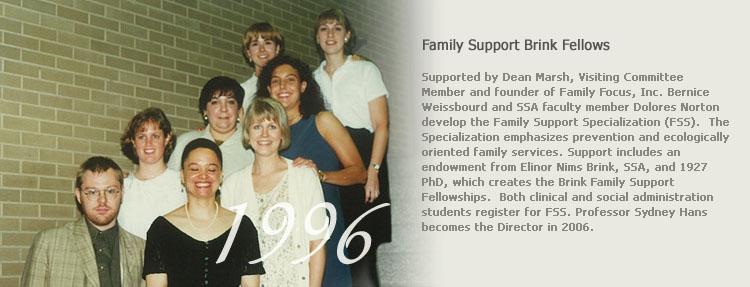
Supported by Dean Marsh, Visiting Committee Member and founder of Family Focus, Inc. Bernice Weissbourd, and SSA faculty member Dolores Norton develop the Family Support Specialization (FSS). The Specialization emphasizes prevention and ecologically oriented family services. Support includes an endowment from Elinor Nims Brink, SSA, and 1927 PhD, which creates the Brink Family Support Fellowships. Both clinical and social administration students register for FSS. Professor Sydney Hans becomes the Director in 2006.
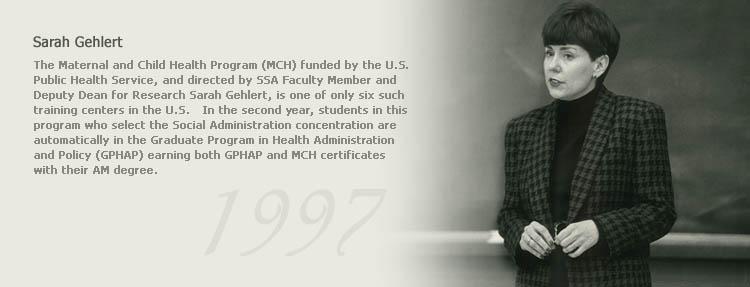
The Maternal and Child Health Program (MCH) funded by the US Public Health Service, and directed by SSA Faculty Member and Deputy Dean for Research Sarah Gehlert, is one of only six such training centers in the US. In the second year, students in this program who select the Social Administration concentration are automatically enrolled in the Graduate Program in Health Administration and Policy (GPHAP) earning both GPHAP and MCH certificates with their AM degree.
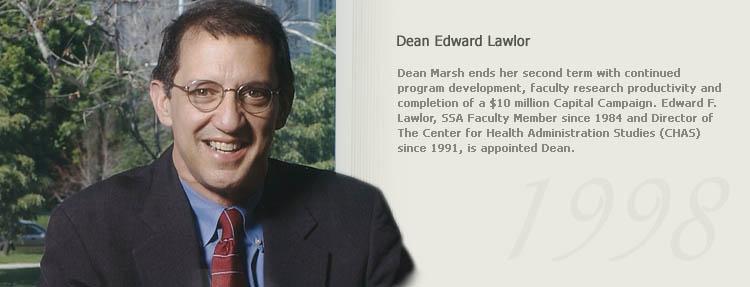
Dean Marsh ends her second term with continued program development, faculty research productivity, and completion of a $10 million Capital Campaign. Edward F. Lawlor, SSA Faculty Member since 1984 and Director of The Center for Health Administration Studies (CHAS) since 1991, is appointed Dean.
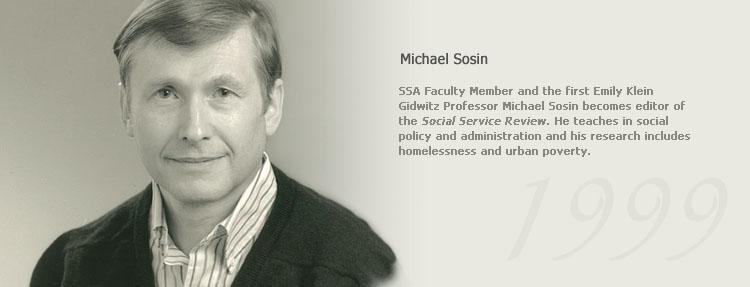
SSA Faculty Member and the first Emily Klein Gidwitz Professor Michael Sosin becomes editor of the Social Service Review. He teaches in social policy and administration and his research includes homelessness and urban poverty.
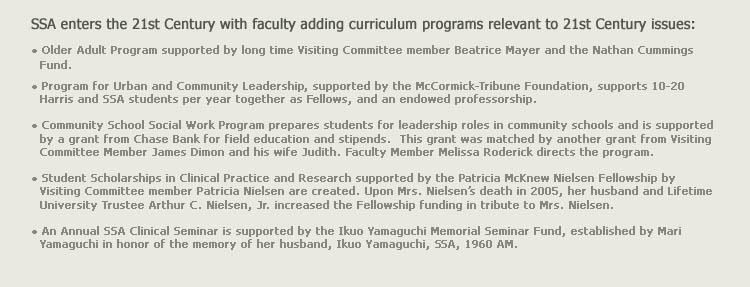
- Older Adult Program supported by long time Visiting Committee member Beatrice Mayer and the Nathan Cummings Fund.
- Program for Urban and Community Leadership, supported by the McCormick-Tribune Foundation, supports 10-20 Harris and SSA students per year together as Fellows, and an endowed professorship.
- Community School Social Work Program prepares students for leadership roles in community schools and is supported by a grant from Chase Bank for field education and stipends. This grant was matched by another grant from Visiting Committee Member James Dimon and his wife Judith. Faculty Member Melissa Roderick directs the program.
- Student Scholarships in Clinical Practice and Research supported by the Patricia McKnew Nielsen Fellowship by Visiting Committee member Patricia Nielsen are created. Upon Mrs. Neilsen’s death in 2005, her husband and Lifetime University Trustee Arthur C. Nielsen, Jr. increased the Fellowship funding in tribute to Mrs. Nielsen.
- An Annual SSA Clinical Seminar is supported by the Ikuo Yamaguchi Memorial Seminar Fund, established by Mari Yamaguchi in honor of the memory of her husband, Ikuo Yamaguchi, SSA, 1960 AM.
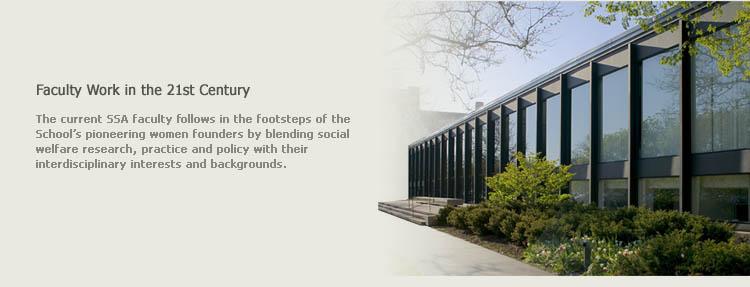
The current SSA faculty follows in the footsteps of the School’s pioneering women founders by blending social welfare research, practice and policy with their interdisciplinary interests and backgrounds.

The Society for Social Work and Research (SSWR) announced that three of its four Doctoral Student Dissertation Fellowships were awarded to SSA doctoral students, Allison Werner-Lin, Jeffry Thigpen, and Julie Darnell, chosen from among 45 national candidates. The Fellowship recognizes proposed dissertation research that reflects innovation and rigorous methods related to social work research practice or policy.
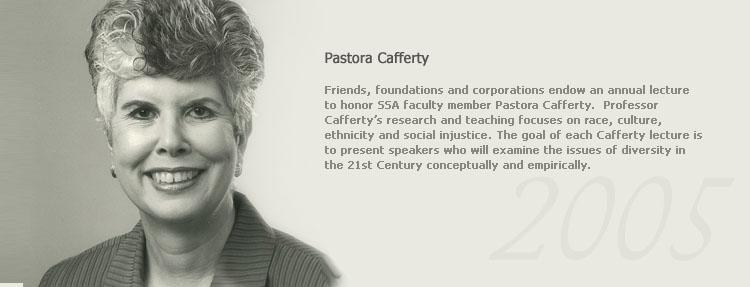
Friends, foundations, and corporations endow an annual lecture to honor SSA faculty member Pastora Cafferty. Professor Cafferty’s research and teaching focuses on race, culture, ethnicity, and social injustice. The goal of each Cafferty lecture is to present speakers who will examine the issues of diversity in the 21st Century conceptually and empirically.
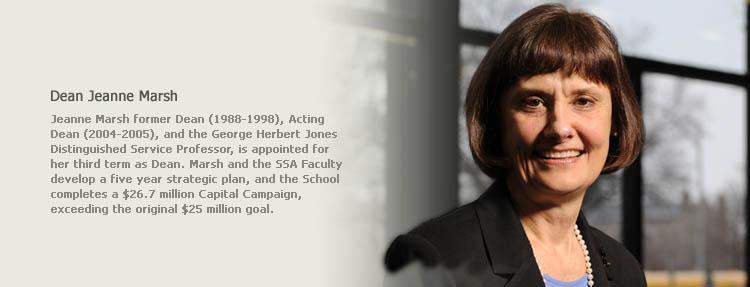
Jeanne Marsh, former dean (1988-1998), Acting Dean (2004-2005), and the George Herbert Jones Distinguished Service Professor, is appointed for her third term as Dean. Marsh and the SSA Faculty develop a five-year strategic plan, and the School completes a $26.7 million Capital Campaign, exceeding the original $25 million goal.
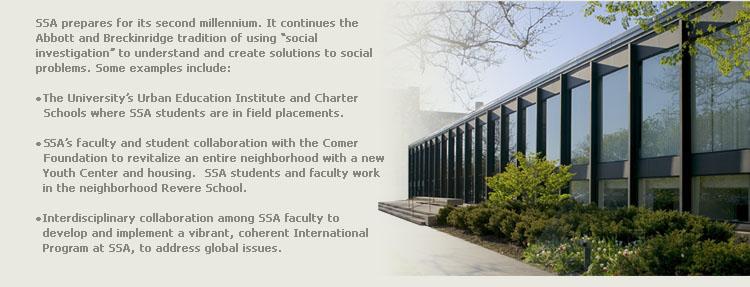
SSA prepares for its second millennium. It continues the Abbott and Breckinridge tradition of using “social investigation” to understand and create solutions to social problems. Some examples include:
- The University’s Urban Education Institute and Charter Schools where SSA students are in field placements.
- SSA’s faculty and student collaboration with the Comer Foundation to revitalize an entire neighborhood with a new Youth Center and housing. SSA students and faculty work in the neighborhood Revere School.
- Interdisciplinary collaboration among SSA faculty to develop and implement a vibrant, coherent International Program at SSA, to address global issues.
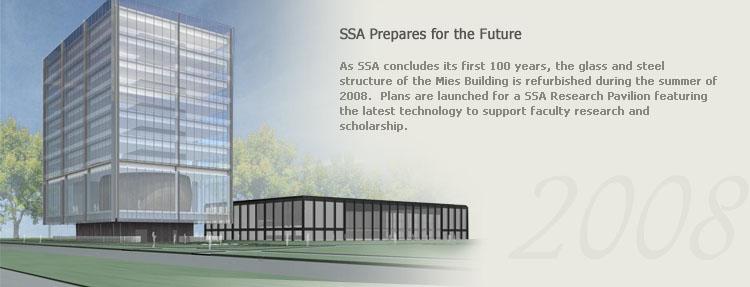
As SSA concludes its first 100 years, the class and steel structure of the Mies Building is refurbished during the summer of 2008. Plans are launched for an SSA Research Pavilion featuring the latest technology to support faculty research and scholarship.
